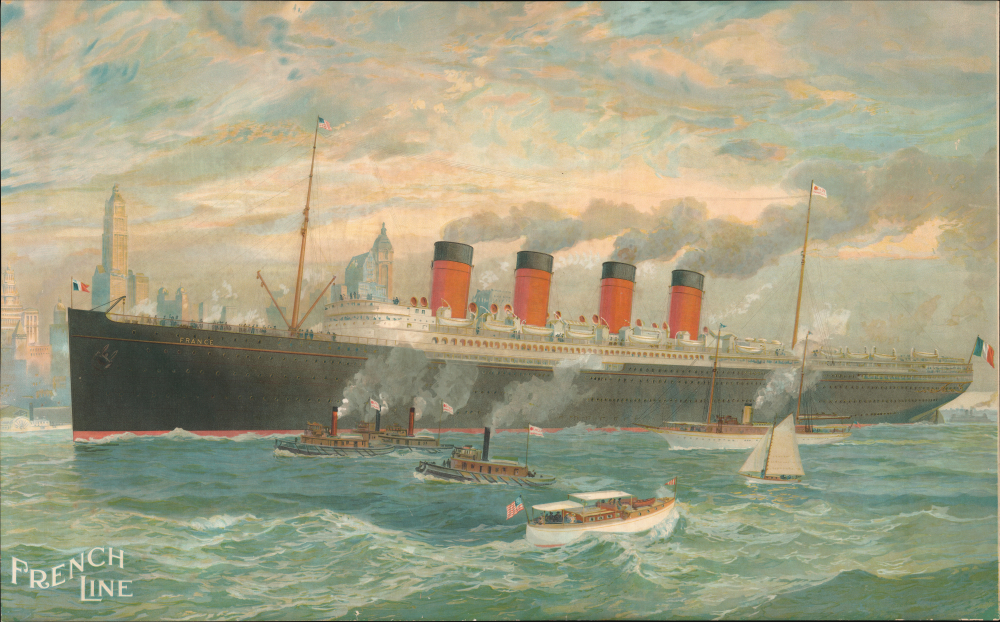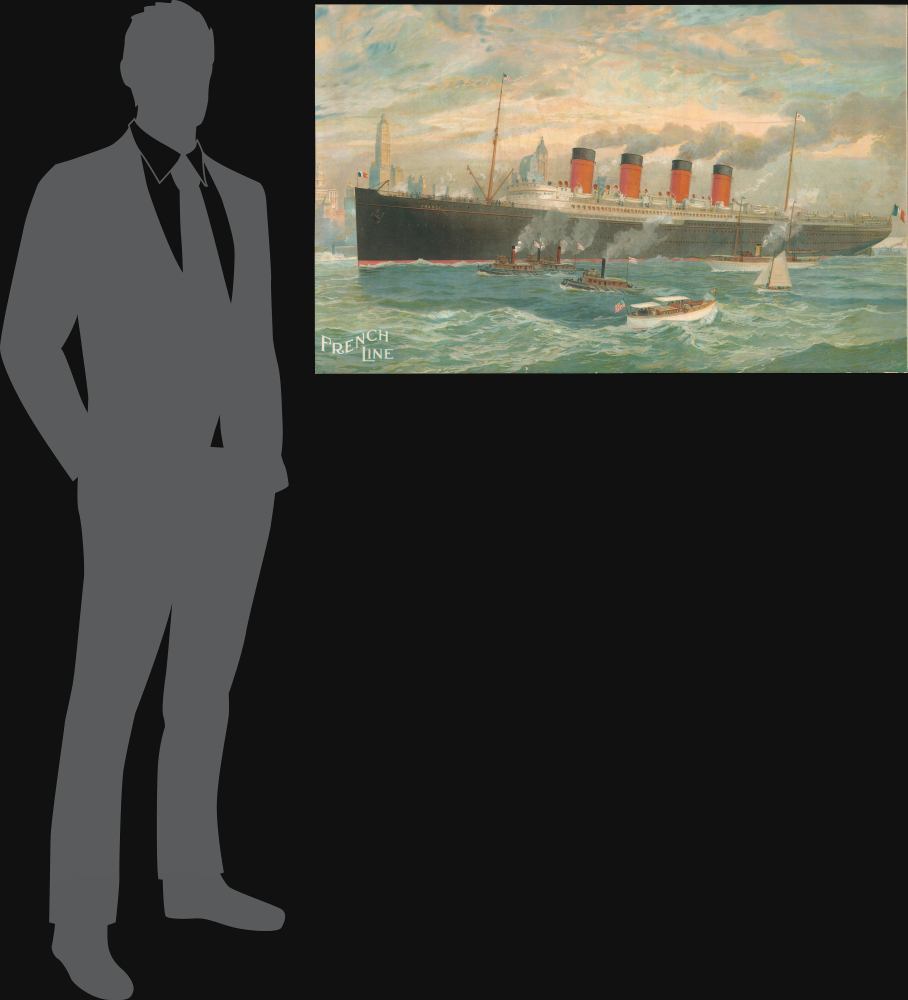1900 Rummell Chromolithograph View of New York for the French Lines Steamships
FrenchLineNewYork-richardrummell-1900
Title
1900 (undated) 25.75 x 41.4 in (65.405 x 105.156 cm)
Description
A Closer Look
The SS France is illustrated steaming northbound on the Hudson River, likely on its 1912 maiden voyage, with New York City in the background. The iconic spires of the Woolworth, Singer, and Park Row buildings are recognizable on the skyline. Well-dressed passengers line the ship's railings, admiring the view. In the foreground, several tugboats operated by the Compagnie Générale Transatlantique prepare to pull the France into port. Dramatic clouds complement the choppy waters of the Hudson.French Line, Compagnie Générale Transatlantique
The SS France was a transatlantic four-stacker steamship operated by the Compagnie Générale Transatlantique (CGT), known as 'French Line'. The 711-foot steamship (for reference, the Titanic was 882 feet) was commissioned in 1908, launched in 1910, and introduced to the transatlantic route in 1912, just a week after the sinking of the Titanic. The new liner represented a landmark achievement in French maritime engineering. It would not only surpass all existing vessels in the French merchant fleet by more than double in size, but also mark several national firsts: the first French liner equipped with four propellers, the only one ever built with four funnels, and the first to utilize Parsons steam turbine propulsion. It was also the most 'electrified' ship afloat. The interior boasted elaborate baroque-revival architecture and interior design, after which it was nicknamed the 'Versailles of the Atlantic'. France was requisitioned and refitted as an armed merchant cruiser for the French navy during World War I (1914 - 1918). After the war, the liner returned to transatlantic passenger service, where she developed a cult-like following among elite passengers. By the early 1930s, however, the France was outclassed by more modern liners and retired from service in 1932. She was sent to the shipbreakers at Dunkirk in 1935.Chromolithography
Chromolithography, sometimes called oleography, is a color lithographic technique developed in the mid-19th century. The process uses multiple lithographic stones, one for each color, to yield a rich composite effect. Generally, a chromolithograph begins with a black basecoat upon which subsequent colors are layered. Some chromolithographs used 30 or more separate lithographic stones to achieve the desired effect. Chromolithograph color can be blended for even more dramatic results. The process became extremely popular in the late 19th and early 20th centuries when it emerged as the dominant method of color printing. The vivid color chromolithography made it exceptionally effective for advertising and propaganda.Publication History and Census
This view was drawn by Richard Rummel and printed in New York for the Compagnie Générale Transatlantique French Line by Albert J. Leon Lithographers. Rare.Cartographer
Richard W. Rummell (1848 – June 4, 1924) was an American artist active in Brooklyn during the late 19th and early 20th century. Rummell was born in Canada, the son of German immigrant Frank X. Rummell and his wife Eliza Rummell. He immigrated to the United States as a youth settling with his parents in Buffalo. He relocated to Brooklyn when he was in his mid-30s, setting up an illustration office at 258 Broadway in Manhattan. Rummell is best known for his series of views of American colleges completed around the turn of the century. Since Rummell's views universally appear to be drawn from an altitude of about 300 feet, it has been speculated by many art historians that he worked from a balloon. Rummell was also a bit of a futurist and among his more interesting works are a series of speculative images of the New York of tomorrow, with vast airships, trains running over the tops of skyscrapers, and elegant sky bridges. In the 1950s, the original printer's plates for many of Rummell's university views were rediscovered in a Brooklyn warehouse. Rummell's Brooklyn home was located at 45 Bay 28th Street and later 73 Hanson Place. In addition to his work as a visual artist, he was an accomplished actor and an avid yachtsman. He founding member of the Bensonhurst Yacht Club, where his yacht, the Careless was usually docked. He was also a member of the Royal Arcanum fraternal order. Rummell was survived by his wife, Emmeline Rummell, daughter, Chrissie Atkinson, and two sons, John Tribel Rummell, and Richard Rummell Jr., who became a famous Florida architect. More by this mapmaker...




